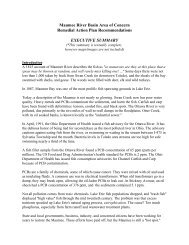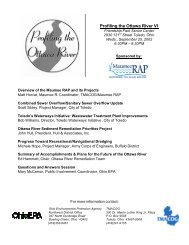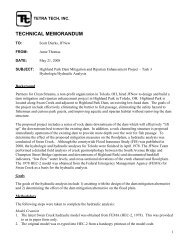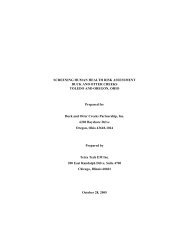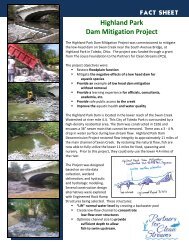Complete report - Partners for Clean Streams
Complete report - Partners for Clean Streams
Complete report - Partners for Clean Streams
You also want an ePaper? Increase the reach of your titles
YUMPU automatically turns print PDFs into web optimized ePapers that Google loves.
Great Lakes Program (GLP)<br />
Founded by the Great Lakes National Program Office (GLNPO) of the US EPA, the<br />
Great Lakes Program is made up of all the programs working to benefit the Great<br />
Lakes region. The Great Lakes Program consists of activities such as RAPs and<br />
Lakewide Area Management Plans. Along with these activities, the GLP helps to<br />
reduce toxic emissions through the Episodic Events/Great Lakes Experiment Study to<br />
work <strong>for</strong> the Lake Michigan Mass Balance Study with research on the air/water<br />
exchange of PCBs and PAHs.<br />
The Great Lakes Binational Toxics Strategy (2000-2006)<br />
This program is a collaborative ef<strong>for</strong>t between the United States and Canada to<br />
reduce or eliminate the toxic substances harmful to the Great Lakes region. The US<br />
EPA and Environment Canada (EC), along with other Governmental Departments, the<br />
Great Lakes states, the Province of Ontario, Tribes, and First Nations are working<br />
together to ensure the health and future of the Great Lakes system. The goal of the<br />
strategy is to involve all aspects of society, not just government, to create a healthy<br />
environment. This strategy <strong>for</strong>med due in part to the Great Lakes Water Quality<br />
Agreement, an agreement between the US and Canada based upon<br />
recommendations by the IJC. The two countries combined to <strong>for</strong>m recommendations<br />
and goals to clean up Lake Erie from unwanted toxins. The release of the toxics are<br />
measured and used to determine the effectiveness of a number of programs. The<br />
goal is to reduce both mercury use and release by 50% by the year 2006 and to<br />
reduce dioxins, furons, and PCBs even further. The current programs were<br />
compared with newer ideas to keep up to date the programming already in place.<br />
Programs such as the Voluntary Mercury Agreement with Northwest Indiana Steel<br />
Mills and the Michigan Mercury Pollution Prevention Task Force have been<br />
implemented to help reduce already present toxins and the addition of new toxins into<br />
the Great Lakes environment.<br />
Integrated Atmospheric Deposition Network (IADN)<br />
2001-2003<br />
Description:<br />
Lead Organization:<br />
The integrated atmospheric deposition network is a monitoring network in both the<br />
United States and Canada, used to assess atmospheric deposition on pollutants in<br />
the Great Lakes area. The network consists of three master stations and two satellite<br />
stations along the Great Lakes in Michigan, New York, Illinois, and Wisconsin. The<br />
stations track the presence of trace organics, trace metals, emerging contaminants,<br />
dioxins/furans, and mercury. The tentative collection dates run from November 1,<br />
2001 until October 31, 2003.<br />
US EPA-GLNPO<br />
Regional Air Pollutant Inventory Development System (RAPIDS)<br />
Ongoing<br />
Description:<br />
In order to determine the state of air quality in Ohio, the Ohio EPA Division of Air<br />
Pollution Control created an inventory as part of the regulatory program of air quality<br />
in Ohio. This emission inventory is a compilation of data describing emissions from<br />
different sources of air pollution such as a utility, refinery, automobile, or trains. With<br />
the in<strong>for</strong>mation, the Ohio EPA creates a system named Regional Air Pollutant<br />
Inventory Development System (RAPIDS), the state’s emission inventory system<br />
Activities and Accomplishments<br />
in the Maumee Area of Concern<br />
209<br />
Issue 14: Atmospheric Deposition



